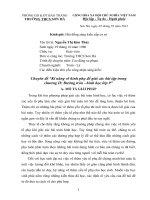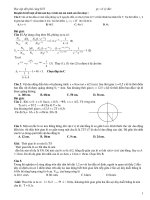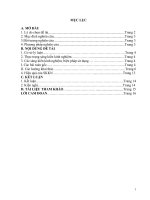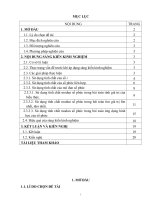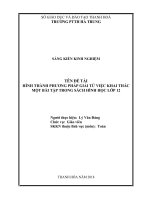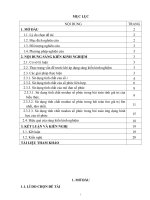Lời giải chương 12 Memory Devices bộ môn hệ thống số
Bạn đang xem bản rút gọn của tài liệu. Xem và tải ngay bản đầy đủ của tài liệu tại đây (299.32 KB, 11 trang )
Instructor's Resource Manual – Digital Systems Principles and Applications - 11th edition
___________________________________________________________________________________________________
CHAPTER TWELVE - Memory Devices
12.1 6x1,024 = 16,384 words; 32 bits/word; 16,384x32 = 524,288 cells
12.2 16,384 addresses; one per word.
12.3 216= 65,536 words = 64K. Thus, memory capacity is 64Kx4.
12.4 Data input lines = 16; Data output lines = 16; Address lines = 13 (2N = 8192)
Capacity in bytes = 16,384 ((8192x16)/8)
12.5 (a) Random Access Memory (RAM) - Memory in which the access time is the same for any location.
(b) Read/Write Memory (RWM) - Any memory that can be read from and written into with equal ease.
(c) Read-Only Memory (ROM) - Memory devices that are designed for applications where the ratio of
read operations to write operations is very high.
(d) Internal Memory - This is also referred to as the computer's main memory. It stores the instructions
and data that the CPU is currently working on.
(e) Auxiliary Memory - This type of memory is also referred to as mass storage. It stores large
amounts of data without the need for electrical power.
(f) Capacity - A way of specifying how many bits can be stored in a particular memory device or
complete memory system.
(g) Volatile - Any type of memory that requires the application of electrical power in order to store
information.
(h) Density - Another term for Capacity.
(i) Read - The operation whereby the binary word stored in a specific memory location is sensed and
then transferred to another device.
(j) Write - The operation whereby a new word is placed into a particular memory location.
12.6 (a) Address bus, Data bus, and Control bus; (b) Address bus; (c) Data bus. (d) CPU.
12.7 (a)
CS 1 produces Hi-Z state outputs; (b) Data out = 11101101
12.8 (a) Only register 11 will have both enable inputs activated; (b) Input address code 0100 will
activate both enable inputs of register 4.
12.9 (a) 16K = 16,384. (b) There are 4 bits per register; (c) 16,384 = 214 = 27x27 = 128x128.
Thus, two 1-of-128 decoders are required.
12.10 (a) True; (b)Process of entering data into the ROM; (c) The delay between the application of a
ROM's inputs and the appearance of the data outputs during a READ operation.
(d) Data Inputs = 4; Data Outputs = 4; Address Inputs = 10; (e) Its function is to activate one
row-select line and one column-select line.
12.11 Since the address inputs to the ROM are stable 500ns prior to the TRANSFER pulse, then our
only concern is to accommodate the tOE delay of 120ns. Thus, the PGT of TRANSFER should not
occur for at least 120ns after its NGT. This neglects the set-up time requirement of the 74ALS273.
12.12 Since the address inputs will have changed only 70ns prior to the NGT of the TRANSFER pulse,
we have to accommodate the access time requirement of 250ns. Thus, the PGT of the
TRANSFER PULSE should occur for at least 180ns after the NGT.
_______________________________________________________________________________________________
214
Instructor's Resource Manual – Digital Systems Principles and Applications - 11th edition
___________________________________________________________________________________________________
12.13
(a) PROM; (b) MROM; (c) All of these memories are nonvolatile; (d) EPROM, EEPROM, FLASH.
(e) EEPROM; (f) EPROM; (g) EEPROM, FLASH; (h) PROM; (i) FLASH; (j) EEPROM, FLASH.
(k) PROM, EPROM, EEPROM, FLASH. (l) EPROM
12.14
Row 3 will be active (HIGH). Thus, transistors Q13, Q14 and Q15 will be conducting.
12.15
Row 0: Connections to the bases of transistors Q3 and Q1 will be made. Connections to the bases
of transistors Q0 and Q2 will be unconnected.
Row 1: Connection to the base of transistor Q4 will be made. Connections to the bases of
transistors Q5, Q6 and Q7 will be unconnected.
Row 2: Connections to the bases of transistors Q8, Q10 and Q11 will be made. Connection to the
base of transistor Q9 will be unconnected.
Row 3: Connections to the bases of transistors Q12, Q13 and Q14 will be made. Connection to the
base of transistor Q15 will be unconnected.
12.16 (a) Counter is initially RESET so that address inputs to EPROM are 000000000000. Switches
are set for desired data. The PROGRAM push-button is depressed and released. This
triggers OS to apply an inverted 50ms PROGRAM PULSE to the EPROM. The NGT of the
PROGRAM PULSE increments the counter to the next address. Likewise, the inverted
PROGRAM PULSE programs the 2732 EPROM with data from the switches. This process is
repeated until each EPROM address has been programmed with desired data.
(b)
(c)
Switch bounce should have no effect because the bounce duration will not exceed 50ms.
_______________________________________________________________________________________________
215
Instructor's Resource Manual – Digital Systems Principles and Applications - 11th edition
___________________________________________________________________________________________________
12.17
(a) Invert A15 and drive CD; Connect RD to OE; Connect WR to WE.
(b) The Data Bus
(c)
12.18
A WRITE cycle
Each data output waveform will change according to the truth table as the counter sequences
through the various addresses. The D0 waveform is shown below.
12.19
Change D7 in truth-table of figure 12.6 (b) so that it has the levels shown above at the various
addresses. Therefore, the hex data will be 5E, BA, 05, 2F, 99, FB, 00, ED, 3C, FF, B8, C7, 27, EA,
52, 5B.
12.20
(a) 100Hz x 256 = 25.6KHz; (b) Adjust Vref.
12.21
(a) Multiplexer
(b) Demultiplexer
(c) To update all DACs simultaneously
(d)
Wave
Triangle
Sine
+ Ramp
-Ramp
A9
1
0
0
1
A8
1
0
1
0
Number
3
0
1
2
_______________________________________________________________________________________________
216
Instructor's Resource Manual – Digital Systems Principles and Applications - 11th edition
___________________________________________________________________________________________________
12.22
(a)
(b)
B
FFH
C
FFH
(c)
(d)
(e)
(f)
120
. Thus, B = 8510 = 55H
360
240
. Thus, C = 17010 = AAH
360
1-Cycle = 256 points 60 cycles/sec = 60 x 256 points/sec = 15,360 Hz
Sequencer outputs A, B, and C must remain active long enough to allow for tpd of the
counter, tacc of the ROM, and tpd of the octal latch.
TCK(min) = 10+20+5 = 35ns
FCK(max) = 1/TCK(min) = 1/35ns = 28.6 MHz
It takes 4 cycles of CK for each DAC-OUT pulse and 256 DAC-OUT pulses per cycle.
TSINE = TCK x 4 x 256 = 35.84 µs
FSINE = 1/TSINE = 1/35.84 µs = 27.9 kHz
It supplies the Most-significant address bits to ROM to select the type of waveform.
_______________________________________________________________________________________________
217
Instructor's Resource Manual – Digital Systems Principles and Applications - 11th edition
___________________________________________________________________________________________________
12.23
12.24
Refer to figure 12.22:
(a) tACC=100ns: (b) tOD=30ns: (c) tRC=100ns; 1/100ns=10 million: (d) tAS=20ns:
(b) (e) tDS+tDH=30ns: (f) tAH=tWC-(tAS+tW )=40ns: (g) tWC=100ns; 1/100ns=10 million
12.25
We save 9 address pins by using address multiplexing, but we need
instead of a single CS. Thus, we save a Net Total of 8 pins.
RAS and CAS signals
_______________________________________________________________________________________________
218
Instructor's Resource Manual – Digital Systems Principles and Applications - 11th edition
___________________________________________________________________________________________________
12.26
12.27
12.28/29 See section 12.15 of text book.
12.30
The cycles of CAS-before- CAS must be applied at least every 7.8µs (4ms/512) in order for the
data to be retained.
_______________________________________________________________________________________________
219
Instructor's Resource Manual – Digital Systems Principles and Applications - 11th edition
___________________________________________________________________________________________________
12.31
2
(a) 2 select bits: 2 = 4 banks.
(b) 8 MB / 4 banks = 2 MB per bank
12
(c) 12 address bits specify the row address: 2 = 4096 rows.
(d) 2 MB per bank = 221. Row address uses 12 bits. Column address must use the rest.
21-12 = 9 bits in the column address register.
12.32
12.33
SRAM 0 has an address range from 000016-1FFF16
SRAM 1 has an address range from 200016-3FFF16
12.34
1)Add four more PROMs (PROM-4 through PROM-7) to the circuit of fig.12.37.
2) Connect AB13 to C input of the 3-line-to-8-line decoder.
3) Connect outputs 4 through 7 of the decoder to the CS inputs of PROMS 4 through 7
respectively.
_______________________________________________________________________________________________
220
Instructor's Resource Manual – Digital Systems Principles and Applications - 11th edition
___________________________________________________________________________________________________
12.35
(1)
(2)
Connect AB13, AB14, and AB15 to the inputs of a 3-input OR gate.
Replace the existing LOW at input C of the decoder with the output of the OR gate.
12.36
(a)
(b)
(c)
The RAM
No. The chip is completely decoded, only one address accesses this memory location.
6007 stores in the EEPROM. Since A11, A12 are not involved in decoding (don't cares)
there are other addresses in the system that will access the same memory location in the
EEPROM as address 6007. They are 6807, 7007, and 7807.
Storing a byte at 6800 will actually write over (and destroy) the byte that was previously
stored at address 6000. A careful programmer will avoid this situation.
(d)
12.37
* Each 64Kx8 module consists of two 64Kx4 RAM chips with their address inputs, chip select inputs and R/W
inputs tied in parallel.
_______________________________________________________________________________________________
221
Instructor's Resource Manual – Digital Systems Principles and Applications - 11th edition
___________________________________________________________________________________________________
12.38
The 74ALS138 is enabled only when E is active and AB12-AB15=HIGH.
12.39
Four more 1Kx8 modules ( 4 through 7) will be added to the circuit of figure 12.42. Their inputs
and outputs will be connected the same way modules 0 through 3 are already connected. Their
CS inputs will be connected to outputs 4 through 7 of the 74ALS138. The new decoding logic is
shown below:
_______________________________________________________________________________________________
222
Instructor's Resource Manual – Digital Systems Principles and Applications - 11th edition
___________________________________________________________________________________________________
12.40
The problem exists because of a permanent logic HIGH at the B input of the 74ALS138. The B
input of the 74ALS138 could:
(a) be internally or externally shorted to Vcc; (b) be floating (open).
12.41
The problem exists because of a permanent logic LOW at the C input of the 74ALS138.
(a) The C input of the 74ALS138 could be internally or externally shorted to Ground.
(b) The OR gate could have its output internally or externally grounded.
12.42
(a)
If a break exists in the connection to the A input of the 74ALS138, this input will act as if it
was always HIGH (A floating input in TTL assumes a logic HIGH). Thus, the binary
sequence at the decoder's input would be as follows:
0012,0012,0112,0112,1012,1012,1112,1112. This would cause the SELF-TEST program to
perform a checkerboard test sequence for RAM module-1 twice in a row, as well as for
RAM module-3. Thus, RAM modules 0 and 2 never get tested. However, the SELF-TEST
program has no way of detecting this fault, and therefore assumes that all four modules test
OK.
(b) The following software implementation can be done in order to detect the preceding fault:
(1)
(2)
(3)
(4)
(5)
(6)
12.43
Clear or Set all memory.
Write a checkerboard pattern to an address (ie.000016).
Read all other memory locations to see if only one memory location contains the
checkerboard pattern.
Clear or Set all memory.
Write a checkerboard pattern to the next address (ie.000116).
Go to step (3) and continue until all memory has been checked.
The 1Kx4 RAM chip with data outputs 4 through 7 which is one half of the RAM module 2,
shows a fault in every location.
Some possible causes:
(a) An unconnected Vcc or Ground on the 1Kx4 RAM chip.
(b) The 1Kx4 RAM chip does not respond to the CS signal.
(c) The CS node connection to the 1Kx4 RAM chip is open.
(d) The R/W node connection to the 1Kx4 RAM chip is open.
12.44
(a) Connection from output 7 of RAM module-3 to data bus line D7 is externally open.
(b) Output 7 of RAM module-3 is internally open or in permanent HI-Z state.
12.45
Since K3 and K2 are shorted together, they will always be at the same voltage level. When
either one is forced to go LOW by the application of its input code, there will be two possibilities:
both K3 and K2 will go to a valid LOW level; or both K3 and K2 will be at some
indeterminate level. In the first case, both RAM modules 2 and 3 will be activated at the same
time whenever the CPU is writing to or reading from either one. This will probably not be
detected by the checkerboard self-test since both RAM modules will respond in exactly the same
way to each write and read operation.
_______________________________________________________________________________________________
223
Instructor's Resource Manual – Digital Systems Principles and Applications - 11th edition
___________________________________________________________________________________________________
In the second case, the indeterminate levels at K2 and K3 will probably result in erratic write
and read operations at all locations in both modules. The self-test messages will probably look
like this:
module-0 test OK
module-1 test OK
address 0800 faulty at bits 0-7
address 0801 faulty at bits 0-7
"
"
"
" "
"
address 0BFE faulty at bits 0-7
address 0BFF faulty at bits 0-7
address 0C00 faulty at bits 0-7
address 0C01 faulty at bits 0-7
"
"
"
" "
"
address 0FFE faulty at bits 0-7
address 0FFF faulty at bits 0-7
12.46
Checksum=DE+3A+85+AF+19+7B+00+ED+3C+FF+B8+C7+27+6A+D2=EA 16
Therefore, checksum at address 11112=111010102=EA16
_______________________________________________________________________________________________
224
